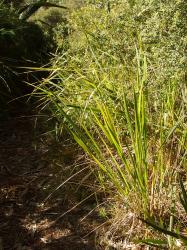- Taxon
- Gallery
Tufted perennials, with rather stiff, loosely sheathing, erect leaves. Leaf-sheath subcoriaceous, striate, keeled, brown to purplish brown, mainly glabrous, but lowermost sheaths with fine silky hairs, especially near base; sheath apex extended upwards at each margin and fused with ligule. Ligule 1–2 mm, truncate, entire. Leaf-blade 10–20–(30) cm × 3.5–5 mm, often narrower than summit of sheath, flat, rather rigid, midrib obvious, abaxially glabrous, adaxially thickly short-pilose near ligule, with a few very long hairs near margin below; margins finely scabrid, tapered to fine but firm tip. Culm (20)–35–70 cm, usually erect, sometimes semi-prostrate, slightly compressed, internodes glabrous, striate. Panicle erect, 6–12 cm, of 3–8 erect to somewhat spreading ± distant racemes; rachis slender, compressed to angular, finely scabrid on angles above. Racemes (2)–3–4 cm; rachis narrowly winged, with very scabrid margins, 1.2–1.7 mm wide, with short white hairs at base, bearing 2 rows of single or paired, shortly pedicelled or almost sessile spikelets; pedicels sparsely scabrid; paired spikelets usually near centre of raceme. Spikelets 2–2.5 mm, imbricate, ovoid-elliptic to ovoid-orbicular, glabrous, obtuse, light brown. Lower glume 0, upper = spikelet, closely appressed to fertile floret, 3–(5)-nerved, glabrous. Lower floret: lemma = spikelet, 3–(5)-nerved, glabrous; palea 0. Upper floret: lemma c. 2 mm, elliptic-orbicular, cartilaginous-indurate, shining, brown, finely punctulate-striolate; palea ≤ and narrower than lemma, membranous margins widened at base, forming wings enclosing flower; anthers c. 1 mm, yellow to brownish; stigmas dark purple; caryopsis slightly > 1 mm.
[From: Edgar and Connor (2000) Flora of New Zealand. Volume 5 (second printing).]




